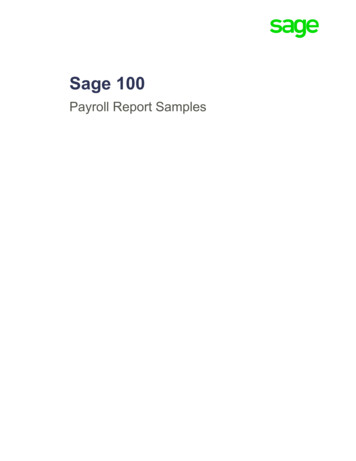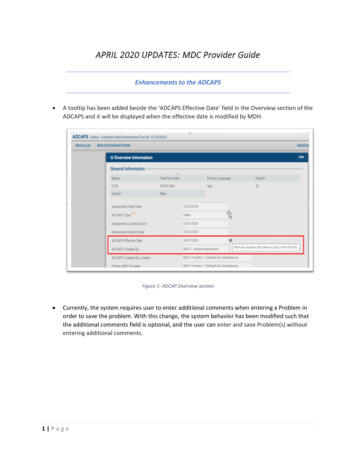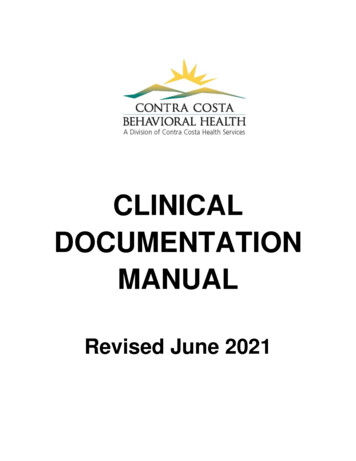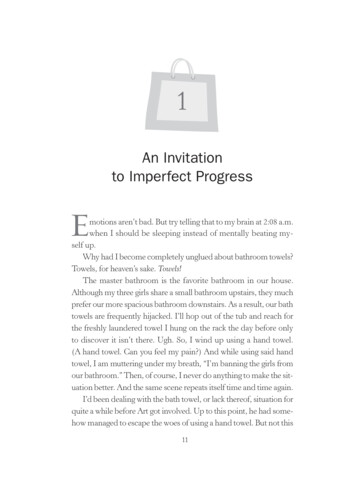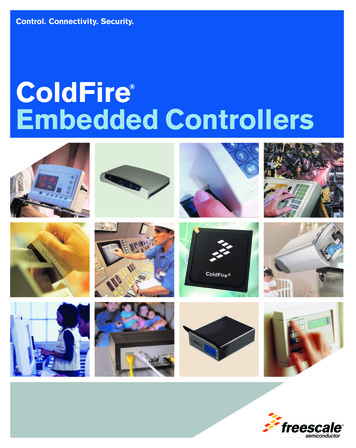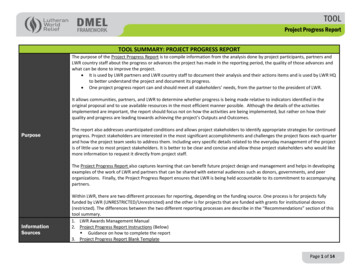
Transcription
TOOLProject Progress ReportTOOL SUMMARY: PROJECT PROGRESS REPORTThe purpose of the Project Progress Report is to compile information from the analysis done by project participants, partners andLWR country staff about the progress or advances the project has made in the reporting period, the quality of those advances andwhat can be done to improve the project. It is used by LWR partners and LWR country staff to document their analysis and their actions items and is used by LWR HQto better understand the project and document its progress. One project progress report can and should meet all stakeholders’ needs, from the partner to the president of LWR.It allows communities, partners, and LWR to determine whether progress is being made relative to indicators identified in theoriginal proposal and to use available resources in the most efficient manner possible. Although the details of the activitiesimplemented are important, the report should focus not on how the activities are being implemented, but rather on how theirquality and progress are leading towards achieving the project’s Outputs and Outcomes.PurposeThe report also addresses unanticipated conditions and allows project stakeholders to identify appropriate strategies for continuedprogress. Project stakeholders are interested in the most significant accomplishments and challenges the project faces each quarterand how the project team seeks to address them. Including very specific details related to the everyday management of the projectis of little use to most project stakeholders. It is better to be clear and concise and allow those project stakeholders who would likemore information to request it directly from project staff.The Project Progress Report also captures learning that can benefit future project design and management and helps in developingexamples of the work of LWR and partners that can be shared with external audiences such as donors, governments, and peerorganizations. Finally, the Project Progress Report ensures that LWR is being held accountable to its commitment to accompanyingpartners.InformationSourcesWithin LWR, there are two different processes for reporting, depending on the funding source. One process is for projects fullyfunded by LWR (UNRESTRICTED/Unrestricted) and the other is for projects that are funded with grants for institutional donors(restricted). The differences between the two different reporting processes are describe in the “Recommendations” section of thistool summary.1. LWR Awards Management Manual2. Project Progress Report Instructions (Below) Guidance on how to complete the report3. Project Progress Report Blank TemplatePage 1 of 14 .
TOOLProject Progress ReportWhoWhenRecommendations Contains a blank template that can be used to enter all the project informationThe Project Progress Report should be completed by one person who attended the Reflection Meeting, ideally the partner projectmanager. This person should be identified at the beginning of the Reflection Meeting so that the LWR PM knows exactly who tocoordinate with. This person will compile all of the analysis from the reflection meeting into the Project Progress Report Blank Template andwill use the Project Progress Report Instructions tool to ensure that the content is entered correctly and covers all therequested topics. The Field, in coordination with IPD-HQ, will work with the sub-recipient to ensure regular and timely submission of highquality performance reports following the reporting schedule outlined in the AAA or CA Appendix 1: Project Summary. Unrestricted Project Progress Reports are completed on either a quarterly (Asia and Africa regions) or bi-annual (LatinAmerica) basis. Restricted Project Progress Reports are completed according to the timeframe set out by the donor.Unrestricted: The process for Unrestricted reporting should utilize the Project Progress Report template, the Indicator TrackingTable, and the Activity Tracking Table. The Reflection Meeting is a recommended method to help analyze the project’s progress andgenerate the content for unrestricted reports. The reporting process and timeline is outlined in Table 2. The Project Progress Report is required for all projects on either a semi-annual or quarterly basis. In some cases, reportsare required on a quarterly basis (e.g. new projects in Africa and Asia). Country Directors should consult with headquartersstaff, and partners should consult with the LWR Program Manager (PM) if clarification is needed. The PM and Partner will ideally work together and with other project stakeholders to analyze and discuss the content of thereport during the Reflection Meeting. The Financial section may need to be revised if it is incorrect before more funds can be disbursed. The partner submits reports to the PM within two weeks of the end of the reporting period. The Country Director reviews the report and provides feedback to the partner via the PM to Partner Cover Sheet within twoweeks of receiving the report. Feedback can include questions about information in the report, recommendations forimproving the reporting, follow-up on LWR accompaniment issues, etc. If there are no questions, recommendations, orother follow-up required, the PM should at a minimum acknowledge that s/he has received and read the report and thatthe project seems to be on track. The PM should maintain records of follow-up correspondence. The partner should use the feedback to improve subsequent reports. PMs and partners should establish clear expectationsconcerning the frequency of visits, how feedback on the report is completed and shared (verbal vs. writtencommunication), and how to follow-up on outstanding issues. This coaching by LWR is an important aspect of partnercapacity building.Restricted: Institutional donors often have a required reporting template and timeframe for submitting reports.Page 2 of 14 .
TOOLProject Progress Report TipsIf the donor does require a template, that template must be used in place of the Project Progress Report and the donor’stimeline must be followed. The Reflection Meeting is also encouraged for restricted reporting, but the focus of the analysis may be slightly differentaccording to the type of information the donor prioritizes. The donor reporting template can be reviewed with a representative from the M&E Unit to determine the best way toutilize and include other LWR tools, such as the Indicator Tracking Table or the Reflection Meeting Guidance, in donorreports that do not specifically request them.All content (narrative/data) in the report goes within the boxes. Use the Project Progress Report Blank Template for your report.GENERAL: Each section of the Project Progress Report is linked to the Reflection Meeting Guidance. If you are unsure of the contentrequested in a section remember to reference the Reflection Meeting Guidance. Remember to update the reporting period every quarter! Be concise. The report should be thoughtful—it should fully explain quarterly progress, but generally should not be morethan 12 pages. Feel free to put particularly important items in bold. After you have completed the report, review it one last time before submitting it. Make sure that the data you filled out forthis quarter is accurate and complete. Once the definitions for direct and indirect have been finalized, document the definitions in the Beneficiary Tracking Table.These definitions will be used for the life of the project. Challenge/issues identified in the report always need to explain what action should be taken (if no action has been taken),what actions were taken, and if that action solved the problem. This is particularly important in Section 2 and Section 3.RESTRICTED: Research the donor strategic plan. Then organize the report’s messages in a way that is consistent with the strategic plan ofthe donor and complies with the award agreement. A cover letter should accompany the report when it is submitted to the donor. Highlight important results and keymessages in the cover letter to the donor (with the report attached).o In the cover letter, the Grants Manager can offer to meet with the donor to discuss the report results if/whenpossible. In the report, include external data to show how the project compared to other projects or why LWR is unique or hasimpact. In the report, be transparent and clear about what parts of the project the donor is funding versus what parts are leveragedfrom other resources. LWR wants the progress reports to help position us for future engagement and funding from the donor.o How do we want to position ourselves with this donor?Page 3 of 14 .
TOOLProject Progress Report o Do we want to continue the project? If so, in what way?Make the report aesthetically pleasing so that it is easy to read for the donor.PM-Partner Cover SheetDate Received byOverseas OfficeDate Received byLWR HQQuestions for Partnerafter Initial PM Reviewof ReportSuggestions for FutureReportingOutstanding IssuesPage 4 of 14 .
TOOLProject Progress ReportSUMMARY TABLEDate Report Submitted:Reporting Period:Partner Name:Project Name and IdentificationNumber:Contact Name:Country:Position Title:Address:Telephone Number:Fax Number:E-mail Address:Project Start Date:Project End Date:Total budget allocated duringreporting period:Total budget spent duringreporting period:Total project budget spent todate:Project Total budgetPage 5 of 14 .
TOOLProject Progress ReportLWR PROJECT PROGRESS REPORT INSTRUCTIONSNote: PLEASE READ THE FOLLOWING INSTRUCTIONS FOR EACH SECTION BEFORE COMPLETING THE PROJECT PROGRESS REPORT. The total Project Progress Report should be between 10-15 pages. This does not include pages taken up by the PM-Partner Cover Sheet, the SummaryTable and photos.Each section has a SECTION SUMMARY that provides general information about the section.Detailed instructions (how to fill out the sections/tables) are provided throughout the document and are highlighted in Green.The suggested page length for each section can be found to the right of the section header.This document contains all instructions. A Project Progress Report Blank Template is available for filling out the report.Detailed steps for compiling the information for this report can be found in the Reflection Meeting Guidance.All projects are strongly encouraged to conduct a Reflection Meeting during each reporting period before writing the report.1. PROJECT BENEFICIARY REPORTING (1-2 SENTENCES)SECTION SUMMARY:The number of project participants is important monitoring data. LWR is committed to promoting gender equity and therefore requires that all participant datais disaggregated based on sex. Through sex-disaggregated data LWR can begin to track the gender impacts of programming on women and men and measurethe progress of women’s achievements as compared to men’s.Direct Beneficiaries: The number of people directly involved in activities and/or who directly benefit from project activities. This information must be updatedeach period using records and reports from the field. It is NOT the initial number of estimated projected beneficiaries from the project proposal.Indirect Beneficiaries: The number of people who can receive a secondary benefit as a result of the project, but who do not participate directly. Depending onthe design of the project, it can include family members of those directly involved in the project, neighbors or even regional populations. It will be a less accurate number than direct beneficiaries and the total number will change less often than direct participants. Provided there are no major changes in the geographic area or scope of the project, the total number will be reported as the same number in the projectproposal or baseline. However, the number of indirect beneficiaries will be updated in cases where the project expands into new communities or newparticipants are added that were not in the original proposal.Page 6 of 14 .
TOOLProject Progress ReportFor both Direct and Indirect beneficiary numbers remember:1. These numbers are real facts, not a projection or estimate.a. They must be backed up with supporting documents such as reports of field technicians, training records, etc.2. These are cumulative numbers.a. They count the number of participants in the project to date, including new additions during the current period.b. Note that this includes participants who are not currently participating in the project, but did participate during at least one reporting period. Ifthe participant was reported in one reporting period (s)he must be included in the Life of Project count.3. The organization that implements the project (partner) will determine the criteria for direct and indirect beneficiaries, using the definitions above asguidelines.a. Once the definitions for direct and indirect have been finalized, document the definitions in the Beneficiary Tracking Table. These definitions willbe used for the life of the project.4. Beneficiary data should be included in this report and also documented in the Indicator Tracking Table in the top right hand corner.TABLE 1.1Beneficiary Tracking TableWomenMenTotalDirect Beneficiaries:Instructions: Document the project’s definition ofdirect beneficiary here.Indirect Beneficiaries:Instructions: Document the project’s definition ofindirect beneficiary here.Instructions:In this area provide a NARRATIVE explanation for any major changes in the beneficiary numbers during the reporting period.Page 7 of 14 .
TOOLProject Progress Report2. KEY MANAGEMENT AND ADMINISTRATIVE UPDATES (1-2 PAGES)SECTION SUMMARY: Updates can be both positive updates as well as challenges/issues that were faced.o If it was a positive update, how will the project use that opportunity to increase the quality and effectiveness of the project? List this in the “Action Required?” column.o If it was a challenge/issue, determine what action should be taken (if no action has been taken), what actions were taken, and if an action taken in apast reporting period solved the problem. An issue/challenge should be included in each Project Progress Report until it has been solved and no longer requires further action. If no additional action is required then the issue/challenge can be removed from the report in the following reporting period.TABLE 2.1UPDATES FROM CURRENT REPORTING PERIODInstructions: Management and administrative issues can include everything from human resources, to security, to partnership/accompaniment issues. For example:o Were key staff hired or fired?o Were there any issues with understanding policies and procedures outlined in the project agreement?o Were there any issues with the partnership between LWR and the partner?o Were there any major security issues?o Did project staff attend any key meetings or technical forums?TABLE 2.2Previous Issues/Updates Encountered From PreviousReporting Period:Instructions: List any Updates from the previous reporting periodthat required action.UPDATES FROM PREVIOUS REPORTING PERIODCorresponding Actions TakenAdditional Action Required? If yes, explain.Instructions: List the action that was taken and theresult here.Instructions: Did the action address the issue? If not, whatmust be done to fully address it? If there was additional action required, list itin the following reporting period until it isfull addressed.Page 8 of 14 .
TOOLProject Progress Report3. ANALYSIS OF IMPLEMENTATION (5-7 PAGES)SECTION SUMMARY:One of LWR’s organizational goals is to be a learning organization that incorporates time for reflection into its work and recognizes best practices and lessonslearned in the course of carrying out its mission. The priority of this section is to analyze the project’s data and information during the reporting period, primarily through analysis of project Outcomeand Output indicators. This analysis helps identify key accomplishments and challenges and determine how they have affected the project in thecurrent reporting period and to date.o The goal of this analysis is to help improve the project’s design, make more informed management and administration decisions, and documentkey lessons learned.The activities sections of the report (3.1.a., 3.2.a, etc.) focus on providing a clear summary of project progress according to the completion of activities. The ActivityTracking Table shows a quantitative summary of activity progress while the narrative boxes in the Project Progress Report provide an opportunity for project staff toexplain any challenges in the implementation of the activities and what they are doing to overcome those challenges.TABLE 3.1GOAL SUMMARYInstructions:This section should include any key findings from Section 2 of the Reflection Meeting which analyzes the general strengths and weaknesses of the project andany lessons learned. It should also include a short summary analysis of 2-3 sentences of the overall progress of the project based on an analysis of the progressfor each OUTCOME and how it relates to progress towards achieving the GOAL.TABLE 3.2OUTCOME 1: ANALYSIS AND REPORTING (Instructions)1. Fill out the indicators/activities with a variance or that have key accomplishments or challenges first.2. Then fill out the summary that analyzes all the indicators and what it means for achieving the RESULT (OUTCOME, OUTPUT, GOAL).OUTCOME 1: (Write the project’s OUTCOME 1 here.)Summary AnalysisInstructions: In this section analyze the progress of the project, in 2-3 sentences, towards achieving this OUTCOME.1. Your analysis should focus first on summarizing the project’s progress towards achieving the OUTCOME indicators for this reporting period. Focus nexton how the progress during this reporting period relates to meeting the Life of Project targets.2. Next, analyze and report on the current progress of ALL the OUTPUTS and how that relates to achieving this OUTCOME. The analysis should highlightboth overall accomplishments and challenges.Page 9 of 14 .
TOOLProject Progress Report Does the project’s progress towards achieving the OUTPUT indicator targets show a relationship with the project’s progress towards meeting theOUTCOME indicator targets?o Remember, there should be a logical, if not direct, relationship between achieving the indicator targets for all of the OUTPUTs and meetingthe OUTCOME indicator targets. Ex: Indicators for Output 1.1, Output 1.2, and Output 1.3 should show a relationship to meeting the result (and indicators) inOutcome 1. Ex: Indicators for Output 2.1, Output 2.2, and Output 2.3 should show a relationship to meeting the result (and indicators) inOutcome 2.Indicator 1.x:IMPORTANT: You MUST report on any indicators that have a -25% variance from the target (lower than 75% and higher than 125%) for that period. If the project has few indicators, only around 1-2 for each OUTPUT and OUTCOME, then report on all indicators. If the project has many indicators, focus the reporting primarily on the indicators with a - 25% variance. Reporting on the remaining indicators isoptional and should focus on indicators that have a KEY accomplishment or challenge. A full list of all the indicators and their data is included in theIndicator Tracking Table, which is included (as an Excel file) with each Project Progress Report.Did the indicator meet its target? Why or why not? If the indicator met or exceeded its target focus on identifying the KEY accomplishments that helped in reaching or exceeding the target. If the indicator did not meet its target, focus on identifying the KEY challenges that the project faced. If there was a challenge, what will the project do toovercome it?OUTPUT 1.1: (write the project’s OUTPUT 1.1 here)Summary AnalysisInstructions: In this section analyze the progress of the project, in 2-3 sentences, towards achieving this OUTPUT.1. Your analysis should focus first on summarizing the project’s progress towards achieving the OUTPUT indicators for this reporting period. Focus next onhow the progress during this reporting period relates to meeting the Life of Project targets.2. Next, analyze and report on the current progress of the ACTIVITIES related to this OUTPUT and how that relates to achieving this OUTPUT. The analysisshould highlight both overall accomplishments and challenges. Does the project’s progress towards completing the ACTIVITIES show a relationship with the project’s progress towards meeting the OUTPUTindicator targets?o Remember, there should be a logical relationship between completing the ACTIVITES and meeting the OUTPUT indicator targets.Indicator 1.1.x:IMPORTANT: You MUST report on any indicators that have a -25% variance from the target (lower than 75% and higher than 125%) for that period. If the project has few indicators, only around 1-2 for each OUTPUT, then report on all indicators.Page 10 of 14 .
TOOLProject Progress Report If the project has many indicators, focus the reporting primarily on the indicators with a - 25% variance. Reporting on the remaining indicators isoptional and should focus on indicators that have a KEY accomplishment or challenge. A full list of all the indicators and their data is included in theIndicator Tracking Table, which is included (as an Excel file) with each Project Progress Report.ACTIVITIES 1.1 (ACTIVITIES LINKED TO OUTPUT 1.1):IMPORTANT: No reporting is required in this box. Generally, for the activities section, only report on activities listed in the project proposal and included in the Activity Tracking Table. This should notinclude a list of tasks needed to accomplish the activities. These tasks are listed in the detailed work plan which can be included as an attachment to thereport.KEY ACCOMPLISHMENTSActivity 1.1.X:Instructions: List all the key accomplishments in implementing the activities linked to the OUTPUT. Report whether each activity has met its target for thereporting period or life of project target, but do not provide further details unless there is a KEY ACCOMPLISHMENT.KEY CHALLENGESACTION ITEMS IDENTIFIED BY PROJECT TEAMActivity 1.1.X:Activity 1.1.X:Instructions: List all the key challenges faced in implementing theInstructions: List all the actions that were taken or the recommended actions that need toactivities linked to the OUTPUT.be taken by the project to address the challenges outlined for each activity listed. You MUST report on ACTIVITIES that achieved less than What, if anything, can be done about the challenges?25% of their target. If there are multiple challenges, ensure that the number of the recommendationscorresponds with the number of the challenge.Challenges Faced From PreviousCorresponding Actions TakenAdditional Action Required? If yes, explain.Reporting PeriodActivity 1.1.X:Activity 1.1.X:Activity 1.1.X:Instructions: List all the challenges facedfrom the previous reporting period here.Instructions: List any actions that were taken toaddress the challenges faced from the previousreporting period here.Instructions: For each challenge faced from the previousreporting period, report if the action taken did not fully addressthe challenge. If the action did not fully address the problem,report on the additional action that must be taken this reportingperiod to fully address the challenge. IMPORTANT: You must report each period on allchallenges until the challenge is listed here as “nofurther action required.”Page 11 of 14 .
TOOLProject Progress Report4. FINANCIAL STATUS (1/2 PAGE)Instructions: Review the project’s overall progress versus the total project budget and the project budget spent until the current reporting period (See Step 5 in theReflection Meeting Guidance for more details). Please describe, if necessary, what cash and/or in-kind contributions community members have made to support the project during this reportingperiod.5. CROSS CUTTING THEMES (1/2-1 PAGES)Instructions:Currently, the only cross-cutting theme identified by LWR (and on which reflection is encouraged) in the report is related to gender. Other project specific crosscutting themes or on the general level of participation of the target group in the project can also be included in this section. The additional cross-cutting themescan be selected by the partner and the LWR program manager, but the section should not exceed 1 page.GENDER:1. Were there any cultural norms that were not identified at the beginning of the project that inhibited males or females from fully participating in thecurrent reporting period?2. Were there gaps between males and females participants in the actual indicator data for the period? If so, why do you think there is a gap? Is the gapaffecting the project? If the gap were reduced would it help the project better achieve its results?3. Did the project take any action to ensure that the participation and the benefits of the project were more equitably shared among all genders?6. PLANS FOR NEXT REPORTING PERIOD (1/2-1 PAGES)Instructions: List any other major management or administrative plans for the next reporting period. You should NOT include a list of all activities for the nextreporting period here. Major activities that might include the participation of key stakeholders (government officials, technical experts, donors) can beincluded in this section.Be sure to include any key meetings project staff will attend with outside agencies, including both governmental, peer agencies, and technical forums.Page 12 of 14 .
TOOLProject Progress Report7. COMMUNITY/PARTICIPANT ACCOUNTABILITY (3-4 Sentences)Instructions:Please give us concrete examples of the major complaints, suggestions or recommendations that you may have heard from participants or other communitymembers during the reporting period, and what actions you took in response. E.g. “Several farmers in Village A complained that the irrigation system installedby the project does not provide sufficient water for farmers at the end of the line. The project engineer is working with the irrigation committee on a plan toshare water more equitably.”Remember an accountability to beneficiaries system should consider the following questions: When and how did you share information with project participants and other community stakeholders about the project, who is benefitting and howthey were selected, who is funding the project, and who is implementing it? If you have not yet done this, when and how do you plan to share thisinformation? (Possibilities include signage, community meetings, radio information, etc.) How have you continued to involve the community throughout all phases of the project since the design phase? How have you received and responded to feedback from participants or other stakeholders? Feedback can include complaints or suggestions.Possibilities include suggestion boxes, public sharing of contact information for project staff, facilitated meetings with stakeholders, etc. How have you documented the feedback you received in this reporting period and your responses?8. PHOTOS AND STORIES (2-3 PAGES)Instructions:LWR’s work in the U.S. includes sharing stories from projects with stakeholders such as donors, our governing board and staff, colleague agencies, and themedia. If you are able, please include information here to help us share your work with others. The local LWR representative has a digital camera and can helpwith taking photos and attaching them to the report. LWR will share with the partner and/or community any materials that have been developed using thesephotos and/or stories within one month of their publication. Please do not delay submission of the report if you are unable to complete this section, and besure to obtain permission to take and use photos as well as make an attempt to get the name of the person who took the photo as well as the person in thephoto.What to include: Name of person(s): (Include the first and last name. Ensure spelling is correct.)Page 13 of 14 .
TOOLProject Progress Report Age(s):Family structure: (Is this person married, have children or grandchildren? How many people are in their household?)Describe the physical location: (What is the landscape like? What do you see nearby? Are there houses, fields, crops, etc?)Describe the challenges faced by this person and their community. Include quotation if possible.How has LWR/this project helped this person to overcome these challenges? What is life like now versus before the project started? Include quotation ifpossible.What are this person’s hopes and dreams for the future? Include quotation if possible.Photo 1 – Caption:Photo 2 – Caption:Photo 3 – Caption:Page 14 of 14 .
Page 2 of 14. Project Progress Report TOOL Contains a blank template that can be used to enter all the project information Who The Project Progress Report should be completed by one person who attended the Reflection Meeti



